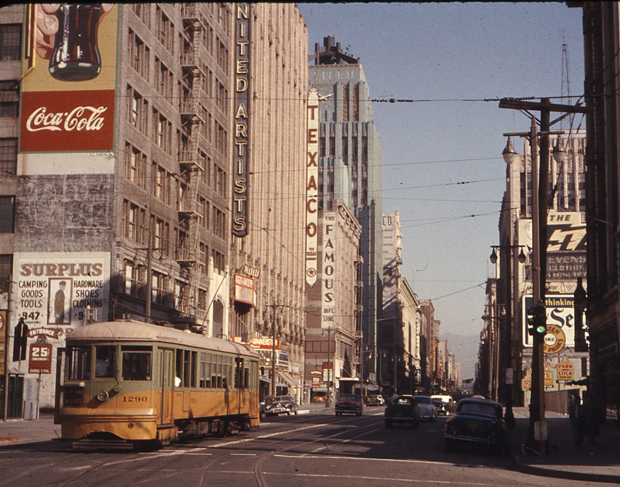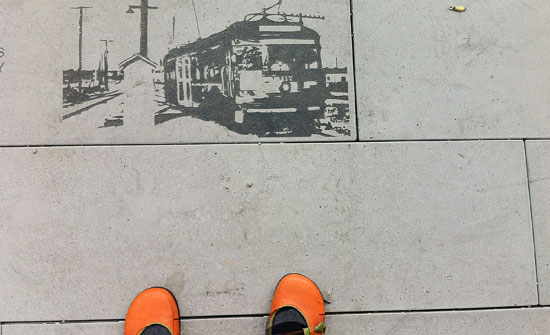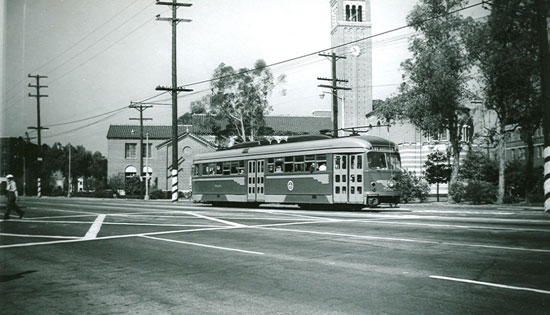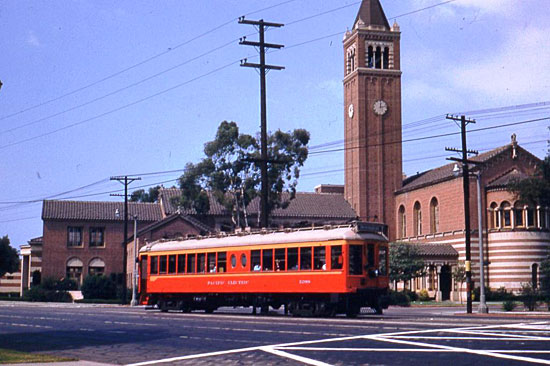Streetcar History
Early Years
During the early and mid-1900′s the historic streetcar served as a popular mode of transportation along Broadway and throughout the Los Angeles region. The streetcar system was primarily operated by Pacific Electric (1901-1961) and developed into the largest trolley system in the world by the 1920′s. This breadth of scale enabled residents and visitors alike to routinely traverse the Los Angeles region, from Santa Monica to San Bernardino. Many modern communities were built around the streetcar network and retain its influence in their gridded street network and relatively dense form. The system operated for over half a century, and at its peak included over 1,100 miles of track with 900 electric trolley cars; this network produced a rate of public transit usage higher than that of modern San Francisco, on a per-capita basis.
For years the system was considered by many to be “the vital cog in the city’s transportation system,” and according to author Steven Ealson, provided transportation for millions who enjoyed the streetcar so much they would “ride for miles simply for fun or for transportation to places of amusement.” The demise of the streetcar began with the unprecedented development of single-family tract housing designed and built to accommodate automobiles. This pattern of development quickened during post-war housing construction, and accelerated the downfall of the streetcar system as the region shifted its focus toward private transportation.
The convenience and accessibility of automobiles, along with increased congestion caused by the proliferation of vehicles, eroded the advantages of the historic streetcar system and led to precipitous declines in ridership and a population shift away from the urban core. Widespread adoption of diesel buses ultimately led to the abandonment of all streetcar systems on March 31, 1963. This ended nearly 90 years of streetcar service in the Los Angeles region.
A New Vision
Rising fuel prices, heavily congested freeways and roadways, and significant environmental impacts have diminished the region’s love affair with the automobile and have brought transit, walkability, and bike-ability back to the forefront. Considered intermittently for a decade, reviving a downtown streetcar is an idea that has been studied by CRA, Metro and the former CCA Red Car Advisory Committee. These efforts all found common ground within Councilmember José Huizar’s Bringing Back Broadway initiative, which is where downtown property owners, businesses, and stakeholders furthered the idea and pushed for the formation of Los Angeles Streetcar, Inc. (LASI).
In the early years of downtown’s push for a local streetcar, the general concept was to create a tourist attraction focusing on historically significant resources while also providing transportation services similar to the Market Street Railway in San Francisco. After considerable research, interviews, tours, and outreach, the focus of the streetcar broadened its scope to promote revitalization and reactivation of historic resources (such as Broadway’s historic theaters and buildings), employment, housing, entertainment, tourism, and general economic development. This larger focus embraces a future-oriented development strategy to link and enhance crucial nodes within downtown that reinforce the area’s diverse mixture of commercial, residential, and historic districts. Today, LASI and our partners with the City of Los Angeles are committed to providing a service that maximizes mobility benefits as well as economic revitalization.
Our efforts are a part of a broader rail renaissance occurring in Los Angeles, beginning with the opening of the Metro Blue Line in 1990, followed by the Metro Red Line in 1993, the Metro Green Line in 1995, the resurrection of the Pacific Electric Red Car Trolley at the Port of Los Angeles in 2003, the Metro Gold Line and Gold Line Extension in 2004 and 2009, respectively, the recent opening of the Expo Line to Santa Monica, and the Westside Subway Extension (“Subway to the Sea”) currently under construction.
Los Angeles is not alone in its efforts to revive streetcar service, improve transit connectivity, and revitalize its urban center. In the last decade, cities across the United States have turned to streetcars as a way to promote transit use and bring new life to aging, underinvested neighborhoods. Portland, Seattle, and Tucson have all been recent examples of success that LASI plans to emulate here at home, in a uniquely Los Angeles way.




